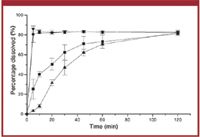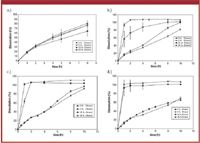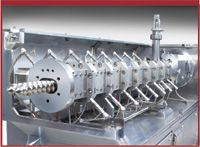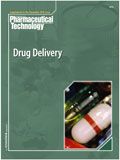Melt Extrusion: Shaping Drug Delivery in the 21st Century
The authors provde a review of melt extrusion's evolution and applications in the pharmaceutical industry. This article is part of a special Drug Delivery issue.
This article is part of a special issue on Drug Delivery
Melt extrusion has been an established industrial manufacturing technology for more than 50 years and has been applied to the production of everything from layered trash bags and space-shuttle parts to synthetic wine corks. During the past decade, the technology has emerged as a viable platform for pharmaceutical development. Today, melt-extrusion applications for pharmaceutical production range from controlled-release systems to oral bioavailability enhancement and show potential for small molecules and therapeutic peptides.
Pioneering development activities in the late 1980s and 1990s spawned several amorphous compositions, including Sporanox (Janssen Pharmaceuticals, Titusville, NJ), Prograf (Astellas Pharma, Deerfield, NJ), and Rezulin (Parke-Davis*), leading to the general acceptance of solid dispersions (1–3). Driven by the continuing development of new chemical entities with limited solubility and industrial aims at continuous commercial manufacturing, melt extrusion has gained acceptance for improving bioavailability and increasing manufacturing efficiencies (4, 5). The emergence of novel drug-delivery systems and routes of administration also have allowed for the expansion of melt-extrusion applications within the pharmaceutical industry. This review article presents an overview of the processing technology, covering four major areas of application: bioavailability enhancement, oral controlled release, melt granulation, and the production of advanced controlled-release dosage forms.
Twin-screw extrusion
Twin-screw extruders (TSEs) process materials in channels bounded by screw flights and barrel walls, and are therefore referred to as small-mass continuous mixers. The motor inputs energy into the process through rotating screws. Process-control parameters include screw speed (rpm), feed rate, temperatures along the barrel and die, and vacuum level (6). Typical monitoring parameters for in-line quality measurement include melt pressure, melt temperature, motor amperage, and near-infrared (NIR) sensors.
TSEs use segmented screws that are assembled on high torque shafts. Barrels are modular and integrate internal bores for cooling. Segmented screws/barrels, in combination with the controlled pumping and wiping characteristics of corotating, self-wiping screws, allow screw and barrel geometries to be matched to the process tasks (6, 7). The counter-rotating intermeshing twin screw mode is also used in the pharmaceutical industry. Solids convey and melt during the first part of the process section. Screw elements for mixing and devolatilization are used as dictated by the process. Discharge elements help to build and stabilize pressure (see Figure 1).

Table I: Oral bioavailability of itraconazole solid-dispersion formulations in healthy volunteers (n = 8). Adapted from Six et al. (Ref. 14).
TSEs are starve-fed, with the output rate determined by the feeder(s), which can meter pellets, liquids, powders, and fibers into the process section (8). The TSE screw speed is independent from the feed rate and used to optimize compounding efficiencies. Because the pressure gradient in the extruder process section is zero for much of the process, materials can be introduced into downstream barrel sections to facilitate sequential feeding (7). For instance, a shear-sensitive active pharmaceutical ingredient (API) can be metered in the latter stages of the process section.
TSE processing offers advantages over batch manufacturing techniques. Polymers are specified to function as thermal binders and act as drug depots and drug-release retardants upon cooling and solidification. Solvents and water are generally not necessary for processing, which reduces process steps. Expensive drying equipment is eliminated as well, along with time-consuming drying steps.
The intense mixing associated with the short interscrew mass-transfer characteristics inherent in a TSE small-mass continuous mixer results in highly efficient distributive and dispersive mixing that leads to a more uniform product compared with large mass-batch mixers (7). Entrapped air, moisture, and volatiles are also removed by vacuum venting during the extrusion process. The short residence time associated with a TSE process compared with a batch process is beneficial for many heat and shear-sensitive materials because the TSE can be designed to limit exposure to elevated temperatures to a few seconds.
A variety of downstream systems, including die face cutters and belt pullers, are available postextrusion. Pellets or shapes may be produced. Film and lamination systems are often used for transdermal and dissolvable film applications, and unique shapes are also possible.
Pelletization is one such downstream process in which the melt stream is pumped through the die, cooled, and formed into a pellet, typically between 0.5 and 5 mm. In strand pelletization, "spaghetti" strands are extruded and cooled on a stainless steel or a US Food and Drug Administration approved plastic belt conveyer (9). The feedrolls of the pelletizer pull the strands and push them into the cutting assembly. Die-face pelletization is also common. In this process, pellets are cut at the die face and conveyed and cooled using equipment such as chilled air chimneys and vibratory towers (10). Smaller pellets can be used for direct capsule filling, whereas larger pellets are typically milled.
To extrude a flat film or sheet, the melt is distributed in the die and cooled on rolls. The roll surface is maintained at the desired temperature by pumping a liquid through internal cooling channels. The molten material solidifies onto the roll while it cools.For some flat products, the nip force across the roll face is used to "squeeze" the extrudate between the rolls. Unwind stations can laminate the film onto a substrate. The final product is then either wound or cut to length (11).
Shape extrusion involves extruding the process melt directly into a part with specific dimensions. The extrudate can be a simple rod or a complex shape, referred to as a "profile." The extruded profile is formed in the die, sized using calibration tooling, and conveyed and supported through air-cooling devices. A belt puller feeds the product to an on-demand or flywheel cutter. In this manner, for example, a 3-mm diameter by 3-mm length tablet can be produced (9, 12).
Bioavailability enhancement. Discovery programs have experienced substantial reductions in new chemical entity solubility, with some reports indicating that approximately 70% of developmental compounds exhibit solubility limitations (13). Dissolution rate and solubility play a role in absorption and oral bioavailability. Because these limitations can play a crucial role in drug absorption of orally administered compounds, new strategies have been developed to improve dissolution rates and enhance metastable solubility. The development of amorphous solid dispersions using melt extrusion represents one of the most effective technologies for oral bioavailability enhancement (4). When compared with its solvent-based counterpart, melt extrusion provides unique advantages in terms of the reduced component nature and improved product density.
The literature provides several examples that demonstrate melt extrusion's ability to improve oral bioavailability of poorly soluble compounds through the production of amorphous solid dispersions. In these systems, the benefit for bioavailability enhancement is derived from three crucial aspects associated with the formulation: 1) improvement in dissolution rate, 2) increased metastable solubility leading to supersaturation and, 3) prolonged duration of supersaturation. The enhancement in dissolution rate is the result of the reduction in specific surface area to the molecular level in combination with the change in enthalpy associated with the absence of a drug substance crystalline structure. Utilization of melt extrusion to disperse the drug into the carrier phase by either melting or dissolving the drug substance in the carrier under elevated temperatures has been extensively reported and is currently used in the commercial manufacturing of Kaletra (Soliqs, Ludwigshafen, Germany) along with many other companies using melt-extrusion products in late-stage development.

Figure 1: Representative schematic of melt-extrusion processing as a function of pressure. (FIGURE 1 IS COURTESY OF THE AUTHOR)
Polymer combinations have been shown in numerous studies to yield amorphous solid dispersions while providing enhanced dissolution rates that led to improved oral bioavailability. There are, however, some examples where increasing the dissolution rate failed to substantially improve oral bioavailability. In a series of studies using itraconazole as the model compound, dissolution rates were improved in vitro (see Figure 2) but failed to provide a substantial improvement for oral bioavailability (see Table I) (14). Subsequent research has shown that the oral bioavailability of itraconazole is associated with an increase in metastable solubility and the ability to maintain supersaturation. Through the combination of poorly soluble drugs with concentration enhancing polymers to prepare amorphous solid dispersions, substantial increases in oral bioavailability can be achieved. Such strategies have shown benefits not just in academic settings but also in industrial applications.

Table II: Comparison of melt-granulated systems with conventional dry-granulation systems. Adapted from Kowalski et al. (Ref. 25).
As part of a Pfizer-Bend Research collaboration, Curatolo et al. studied the utility of 41 materials for the concentration enhancing benefits provided to nine proprietary and model drug substances (15). Their results demonstrated broad effectiveness of hypromellose acetate succinate (HPMCAS) to provide superior concentration enhancing behavior. Similar concentration enhancing behavior of HPMCAS has also been demonstrated using hot melt extrusion and the excellent melt properties of the polymer make it an appropriate material for use as a carrier in melt extrusion. HPMCAS, however, is not a universal solution to solubility enhancement. Other commonly used pharmaceutical polymers such as Kollidon VA 64 (BASF, Florham Park, NJ), Eudragit L100-55, and Eudragit E PO (Evonik, Parsiappany, NJ) have been shown to provide application for bioavailability enhancement.
With regard to selecting a processing technology for oral bioavailability enhancement, the literature shows that the technology used contributes to the observed dissolution rate of a solid dispersion. Patterson et al., showed in a comparative study that the distribution obtained by melt extrusion was more homogeneous than that obtained by spray drying, which exhibited some drug rich regions within the matrix (16).
There are some perceived limitations to using melt extrusion, specifically with regard to elevated-temperature processing. Although melt extrusion may not be an obvious choice for the production of extremely thermally-labile drug-substance solid dispersions, it has shown significant utility with high melting point compounds. Literature reports have shown the ability to process at temperatures almost 50 °C below drug substance melting points and still achieve amorphous material with a drug loading of more than 30% (17). Additionally, the development of analytical technologies to characterize pharmaceutical polymer stability has further improved control over the processing variables. By developing an understanding of processing variable impact on polymer stability, one can more appropriately control the manufacturing process to ensure appropriate critical product attributes. Through careful consideration of critical processing parameters during melt extrusion, it is possible to cover a similar range of molecular properties while also yielding potential improvements in solid-dispersion attributes by reducing the number of manufacturing phases.
Oral controlled release. The most traditional manufacturing technique for sustained-release dosage forms is compression such as roller compaction or tableting, which creates a matrix as the result of the formation of solid bridges. When subjected to a compression force, drug and excipient particles undergo transitional packing. With an increase in the compression force and densification of the formulation composition, deformation occurs at the points of contact of drug and excipient particles. Ductile materials such as microcrystalline cellulose undergo plastic deformation while brittle materials such as lactose undergo brittle fracture. Solid bridges are formed between particles when adjacent surfaces come into contact at the atomic level.

Figure 2: Dissolution of itraconazole solid-dispersion formulations: Sporanox (Janssen Pharmaceuticals) (â²), Hypromellose extrudate (â ), Eudragit (Evonik) E100 extrudate (â¼), and Eudragit (Evonik) E100-PVPVA64 extrudate (
•).The dissolution (paddle method) was carried out in 500 mL SGFsp, at 37 °C, 100 rpm. Error bars indicate the standard deviation. (FIGURE 2 IS REPRODUCED WITH PERMISSION FROM SIX ET AL (REF. 14) BY ELSEVIER)
A TSE process has been successfully applied to a prepared sustained-release drug-delivery system (18). Commonly used polymeric drug-release retardants such as Eudragit RS, ethyl cellulose, and hydroxypropyl cellulose are thermal plastic materials that can be readily processed in a TSE. During the extrusion process, polymeric drug-release retardants are fed and transferred inside the heated barrel by corotating (or counter-rotating) twin screws. The polymeric materials soften as a result of the shearing effect of the rotating screws. The molten mass is then pumped through the die attached to the end of barrel by the screws and transformed into different physical shapes. The extrudate can either be directly shaped into a dosage form (19) or milled down to granules which can be further processed into final dosage forms with a traditional compression process (20).
The mechanism for matrix formation during the melt-extrusion process is different from that during the compression process. When processed above their glass-transition temperature and subjected to high pressure, thermoplastic components of the formulation function as adhesive binders inside the extruder and are intimately mixed with other components. Thermoadhesive characteristics of polymeric drug-release retardants are the mechanism for the formation of the matrix prepared using melt extrusion. Therefore, good compaction properties required for the matrix formation in a compression process are not necesssary. Finished products are expected to have lower porosity, higher tortuosity, and higher density in comparison with the dosage forms prepared by conventional compression processes. For a diffusion-controlled drug-delivery system, slower drug release is typically observed from materials processed using a melt extrusion process.
Strong interaction between individual components in the formulation can also occur during the extrusion process because certain materials are mixed at the molecular level. Zhang and McGinity have observed the formation of insoluble chlorphenamine maleate and Eudragit 4135F complexes due to hydrogen bond formation during the extrusion process (18). Exploitation of such interactions in combination with greater control of diffusive properties of the matrix can be exploited to provide unique sustained release properties. Additionally, abuse-deterrent and dose-dumping characteristics can be built into system using melt-extruded matrix technologies. In a recent study by Roth and colleagues, researchers used Soliqs' Meltrex technology to prepare ethanol resistant tablets of verapamil (21). Their research showed improved performance in vitro and in vivo.
Melt extrusion also has been used as an oral controlled platform for the production of minitablets and as a means to facilitate the compression of multiparticulates. In a study conducted by De Brabander et al., researchers manufactured minitablets using melt extrusion to prepare zero-order sustained-release tablets of ibuprofen that showed stability for a 12-month storage period (22). Schilling et al. also reported on the application of melt extrusion to prepare matrices containing film-coated multiparticulates (23). Under this design, the pellets were extruded with an external matrix agent and milled into a compressible granular powder which could be combined with extragranular materials to provide improved compression cushioning while allowing for controlled release. This technology could potentially allow for successful manufacture of tablets containing multiparticulates.
The literature shows overall that a melt-extrusion platform can provide many benefits for the production of controlled-release systems. The ability to manufacture conventional controlled-release systems while maintaining the potential for single-step dosage form manufacture presents unique opportunities for continued growth of this technology.
Melt granulation. Traditionally, melt granulation is carried out in a high-shear granulator with a double-jacketed granulation bowl where water or oil is circulated as the heating medium. The disadvantages of this traditional process include inefficient processing due to the slow heat transfer from the bowl to the powder blend; difficulty in process scale up because the area of the heated surface to the volume of power blend decreases with an increase in batch size; and batch-to-batch variability associated with inconsistent heat transfer.
The working principle for a TSE is different from that of a high shear granulator. The TSE is an "active mixer" where the mechanical energy of rotating screws (rather than the heat conducted from the barrel) melts or softens the fed materials. Ideally, minimal heat should transfer between the extruder barrel and the materials passing through the barrel. As a result,a melt-granulation process based on TSE can be scaled up more easily. During extrusion, the formulation composition is also subjected to high pressure, which results in granules with a higher density and better flowability compared with granules obtained from a high-shear granulator.
In TSE for melt granulation, a binder that melts or softens at a relatively low temperature (60 to 80 °C) is used to achieve the agglomeration of the formulation composition. Originally adapted from conventional wet-granulation techniques applied in a continuous fashion, the granules are formed after the material exits the die and the molten binders solidify. The binders can be divided into two categories: hydrophilic excipients such as polyethylene glycol, poloxamer, cremorphor and sucrose acetate; and hydrophobic excipients such as triglycerides, wax, stearic acid, and hydrogenated vegetable oil. Thermal binders are typically present in the formulation at the 5–30% level.
Selection of the binders is based on drug–excipient compatibility and desired drug-release profiles. For example, hydrophobic excipients have been used to prepare sustained-release dosage forms (24) and to provide better protection of the moisture sensitive drug substance (25). In a recent publication by Kowalski et al., the researchers described the use of melt extrusion for producing high drug loading granules containing a moisture-sensitive drug for use in a combination product. Using melt extrusion, the researchers produced highly compressible granules that yielded tablets with minimal weight variation. Additionally, they were able to demonstrate that the presence of the low molecular weight lipophillic binder used (hydrogenated castor oil) improved high humidity stability of the moisture sensitive product (see Table II).

Figure 3: Dissolution profiles of verapamil formulation concepts. a.) Minimal ethanol dependence is shown. This formulation was prepared using Meltrex (Soliqs) technology. Profiles b, c, and d were prepared using conventional technologies. (FIGURE 3 IS REPRODUCED WITH PERMISSION FROM W. ROTH ET AL. BY ELSEVIER)
Advanced systems. The design of advanced drug-delivery systems has moved to the forefront of pharmaceutical technology, with many new systems available for targeted and alternative delivery. In the design of such systems, which in many cases requires unique geometries and compositions to achieve the target product profile, melt extrusion and supporting downstream processing can provide unique advantages. The ability to generate systems of almost any shape from various materials also offers unique dissolution profiles.
Although the majority of melt-extrusion applications have focused on oral delivery, commercially marketed melt-extruded products are already available, including NuvaRing (Merck-Schering Plough, Whitehouse Station, NJ) which uses a coaxial extrusion process to imbed etonogestrel and ethinyl estradiol into an ethylene vinyl acetate (EVA) core matrix. The core matrix is coextruded with an exterior skin of EVA, which regulates drug release and provides a near zero-order rate of release over a 21-day period. Following extrusion, the extrudate rods are cut and end-fused to create a ring (see Figure 5) capable of being inserted into the vagina. Through careful regulation of the outer layer thickness and core drug concentration, the developers were able to control the drug-release rate while providing a safe and easy-to-use product for extended duration delivery (26). Another example of an advanced drug-delivery system developed using melt extrusion is the anti-HIV vaginal ring by Particle Sciences. Under their process, dapirvirine is coprocessed with cellulose acetate phthalate before being melt extruded in an EVA matrix. The extruded material is milled and shaped using an injection molding device to create a final ring capable of zero-order release for a 90-day period (27).

Figure 4: The NuvaRing device (Merck-Shering Plough). (FIGURE 4 IS COURTESY OF THE AUTHOR)
Another far less common example of a melt-extruded shaped system is Lacrisert (Aton Pharma, Lawrenceville, NJ), a hydroxypropyl-cellulose rod inserted into the pocket of the patient's lower eyelid to minimize symptoms associated with dry eyes. This product is extruded and cut to length to generate a finished product which is then cured in humidity chambers to achieve equilibrium moisture content. Similar systems for ocular delivery are under development. In a recent study by Jain et al., a system capable of delivering acyclovir with twice daily dosing was developed. The system showed a substantial improvement over the ocular ointment which requires dosing five times per day (28).

Figure 5: Processing Section of a 50-mm Pharmaceutical Grade Melt Extruder (Leistritz). (FIGURE 5 IS COURTESY OF THE AUTHOR)
Melt-extrusion applications have expanded beyond conventional small-molecule applications. A study by Rothen-Weinhold et al. showed that melt extrusion of a model peptide, vapreotide, was possible using a poly(lactic-co-glycolic acid) carrier while minimizing degradation due to the elevated temperature exposure (29). Given the recent development of localized peptide therapies that require novel dosage form engineering, melt extrusion presents unique advantages as a manufacturing platform.
Future directions
Melt extrusion in the pharmaceutical industry continues to evolve. Machinery suppliers have downsized and redesigned equipment for current good manufacturing practice environments (see Figure 5). Additional efforts have been made to design TSE systems that can test early-stage materials which are available only in minimal quantities. Borrowing from the plastics industry, coextruded products using multiple extruders, and integration with in-line molding, may be the next generation of development efforts. With the continued development of manufacturing technologies along with advances in formulation design and drivers for increased production efficiency, melt extrusion will continue to shape drug delivery in the 21st century.
*Rezulin is no longer marketed. Parke-Davis is now part of Pfizer (New York).
Acknowledgments
The authors would like to thank Andrew Kenna and Marshall Cisneros with PharmaForm for their contributions during internal PharmaForm studies to support this manuscript.
James C. DiNunzio, PhD, is a principal scientist at Hoffmann–La Roche, Inc. (Nutley, NJ). Charlie Martin* is general manager of Leistritz (Somerville, NJ), tel. 908.685.2333, ext. 616, cmartin@alec-usa.com. Feng Zhang, PhD, is vice-president of development R&D at PharmaForm (Austin, TX).
To whom all correspondence should be addressed.
References
1. R. Chokshi and H. Zia, Iranian Jrnl. of Pharm. Res. 3, 3–16 (2004).
2. P.M. Gilis et al., Beads Having a Core Coated with an Antifungal and a Polymer, W.P. Organization, 1997.
3. K. Yamashita et al., Intern. Jrnl. of Pharmaceut. 267 (1–2), 79-91 (2003).
4. J. Brouwers, M.E. Brewster, and P. Augustijns, Jrnl of Pharm. Sci., 98(8), 2549 - 2572 (2009).
5. M.A. Repka et al., Expert Opin. on Drug Deliv. 5 (12), 1357–1376 (2008).
6. M. Mollan, "Historical Overview," in Pharmaceutical Extrusion Technology (I. Ghebre-Sellassie and C. Martin, Eds., Marcel Dekker, New York, 2003) pp. 1–18.
7. W. Thiele, "Twin-Screw Extrusion and Screw Design" in Pharmaceutical Extrusion Technology (I. Ghebre-Sellassie and C. Martin, Eds., Marcel Dekker, New York, 2003) pp. 69–98.
8. W. Doetsch, "Material Handling and Feeder Technology," in Pharmaceutical Extrusion Technology (I. Ghebre-Sellassie and C. Martin, Eds., Marcel Dekker, New York, 2003) pp. 111 –134.
9. J. Perdikoulias and T. Dobbie, "Die Design," in Pharmaceutical Extrusion Technology (I. Ghebre-Sellassie and C. Martin, Eds., Marcel Dekker, New York, 2003) pp. 99–110.
10. C.C. Case, "Melt Pelletization," in Pharmaceutical Extrusion Technology (I. Ghebre-Sellassie and C. Martin, Eds., Marcel Dekker, New York, 2003) pp. 171–182.
11. B. Elliott, "Film, Sheet and Laminates," in Pharmaceutical Extrusion Technology (I. Ghebre-Sellassie and C. Martin, Eds., Marcel Dekker, New York, 2003)p. 225 – 244.
12. B. Bessemer, "Shape Extrusion," in Pharmaceutical Extrusion Technology (I. Ghebre-Sellassie and C. Martin, Eds., Marcel Dekker, New York, 2003) pp. 209–224.
13. D.J. Hauss, Adv. Drug Deliv. Rev. 59 (7), 667–676 (2007).
14. K. Six et al., Pharm. Res. 20 (3), 1047–1054 (2003).
15. W. Curatolo, J.A. Nightingale, and S.M. Herbig, Pharm. Res. 26 (6), 1419–1431 (2009).
16. J.E. Patterson et al., Internat. Jrnl. of Pharmaceut. 336 (1) (2007).
17. J. C. DiNunzio, "Formulation Design of Melt Extruded Systems for Oral Bioavailability Enhancement" presented at Leistritz Pharmaceutical Extrusion Seminar, Clinton, NJ, 2010.
18. F. Zhang, "Hot-melt Extrusion as a Novel Technology to Prepare Sustained-Release Dosage Forms," in Division of Pharmaceutics (University of Texas at Austin, 1999) p. 259.
19. R. Spengler and J. Rosenberg, Methods of Produing Solid Dosing Forms (USPT Office, Ed., Abbott Laboratories, USA, 2003).
20. J.W. McGinity et al., "Hot-Melt Extrusion Technology," in Encyclopedia of Pharmaceutical Technology (J. Swarbrick, Ed., Informa Healthcare, New York, 2006).
21. W. Roth et al., Internat. Jour. of Pharmaceut. 368 (1–2), 72–75 (2009).
22. C. De Brabander et al., Internat. Journ. of Pharmaceut. 271 (1–2), 77–84 (2004).
23. S.U. Schilling and J.W. McGinity, Internat. Journ. of Pharmaceut. In-press (2010).
24. L.E. Appeal et al., Azithromycin Multiparticulate Dosage Forms by Melt-Congeal Processes (USPT Office, Ed., Pfizer, USA, 2004) p. 25.
25. J. Kowalski, et al., Internat. Journ. of Pharmaceut. 381 (1), 56–61 (2009).
26. W. De Graaff et al., Drug Delivery System Based on Polyethylene Vinylacetate Copolymers, (USPT Office, Ed., N.V. Organon, US, 2007) p. 14.
27. A. Loxley, "Hot Melt Extrusion in the Preparation of Anti-retroviral-releasing Intravaginal Rings" presented at Leistritz Pharmaceutical Extrusion Seminar, Clinton, NJ, 2010.
28. S. Jain et al., Indian Journ. of Pharmaceut. Sci. 69 (4), 562–567 (2007).
29. A. Rothen-Weinhold, Euro. Jrnl. of Pharmaceut. and Biopharmaceut. 49 (3), 253–257 (2000).

Drug Solutions Podcast: Applying Appropriate Analytics to Drug Development
March 26th 2024In this episode of the Drug Solutions Podcast, Jan Bekker, Vice President of Business Development, Commercial and Technical Operations at BioCina, discusses the latest analytical tools and their applications in the drug development market.